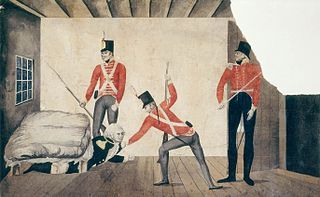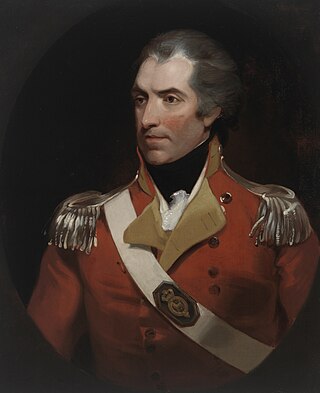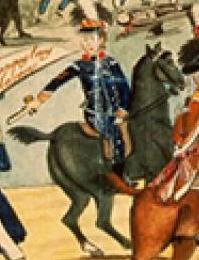| |||||
| Decades: | |||||
|---|---|---|---|---|---|
| See also: | |||||
The following lists events that happened during 1808 in Australia.
| |||||
| Decades: | |||||
|---|---|---|---|---|---|
| See also: | |||||
The following lists events that happened during 1808 in Australia.
Governors of the Australian colonies:

The Rum Rebellion of 1808 was a coup d'état in the then-British penal colony of New South Wales, staged by the New South Wales Corps in order to depose Governor William Bligh. Australia's first and only military coup, the name derives from the illicit trade of rum in early Sydney, over which the 'Rum Corps', as the New South Wales Corps became known, had maintained a monopoly. During the first half of the 19th century, it was widely referred to in Australia as the Great Rebellion.

Philip Gidley King was a British politician who was the third Governor of New South Wales.

Colonel William Paterson, FRS was a Scottish soldier, explorer, Lieutenant Governor and botanist best known for leading early settlement at Port Dalrymple in Tasmania. In 1795, Paterson gave an order that resulted in the massacre of a number of men, women and children, members of the Bediagal tribe.

John Macarthur was a British Army officer, entrepreneur, landowner and politician who was a highly influential figure in the establishment of the colony of New South Wales. He was also a pioneer of the Australian Merino wool industry, and was instrumental in agitating for, and organising, a rebellion against Governor William Bligh in what is now termed as the Rum Rebellion in January 1808.
Joseph Foveaux was a soldier and convict settlement administrator in colonial New South Wales, Australia.
The following lists events that happened during 1805 in Australia.
The following lists events that happened during 1806 in Australia.
The following lists events that happened during 1807 in Australia.
1813 in Australia featured a number of important developments. Gregory Blaxland, William Lawson and William Charles Wentworth crossed the Blue Mountains which opened up the interior of New South Wales for European settlement. John and Elizabeth Macarthur sent the first wool exports from their properties.

Lieutenant-Colonel George Johnston was a British military officer who served as Lieutenant-Governor of New South Wales, Australia after leading the rebellion later known as the Rum Rebellion. After serving as a young marine officer in the American Revolutionary War, Johnston served in the East Indies, fighting against the French, before volunteering to accompany the First Fleet to New South Wales. After serving as adjutant to Governor Arthur Phillip, Johnston served in the New South Wales Corps and he was a key figure in putting down the Castle Hill convict rebellion in 1804. He led his troops in deposing Governor Bligh in the Rum Rebellion in 1808; which led to his court martial and subsequent cashiering from military service. In his later life, he returned to New South Wales as a private citizen, raising a family in the colony and establishing a successful farm around Annandale in Sydney.

Lieutenant-General Sir Edward Macarthur was a lieutenant-general in the British Army, Commander-in-chief of British forces in Australia from 1855, and an administrator of the Colony of Victoria for 12 months, following the death of the Governor, Sir Charles Hotham.
Edward Abbott was a soldier, politician, judge-advocate and public servant who served at Parramatta, the Hawkesbury River and Norfolk Island in the colony of New South Wales, now part of present-day Australia. He also served at the settlements of Launceston and Hobart in Van Diemen's Land, which was part of New South Wales until 1825, when Van Diemen's Land became a self-governing colony.
Anthony Fenn Kemp was a soldier, merchant and a deputy judge advocate of the colony of New South Wales. He was one of the key participants in the "Rum Rebellion" that removed William Bligh, the appointed governor of the colony, and established an interim military government. He was later permitted to settle in Van Diemen's Land and became a successful merchant and farmer there.
HMCS Integrity was a cutter built by the Colonial Government of New South Wales in 1804. She was the first vessel ever launched from a New South Wales dockyard and carried goods between the colony's coastal settlements of Norfolk Island, Newcastle, New South Wales, Van Diemen's Land and Port Jackson. In 1804 she took part in a series of voyages to Van Diemen's Land with the aim of founding a colony at Port Dalrymple, the site of the modern settlement of George Town, Tasmania.

Thomas Laycock was an English soldier, explorer, and later businessman, who served in North America during the War of 1812, but is most famous for being the first European to travel overland through the interior of Tasmania.
Martin Mason was a surgeon, magistrate and commander who is notable as a pioneer settler of Australia, and also as a supporter of Captain Bligh following the 1808 Rebellion at Sydney, New South Wales.
Andrew Thompson was transported at the age of 18 to New South Wales, arriving in Sydney on 14 February 1792. He rose to become a respected chief constable in the Hawkesbury district, a successful farmer and businessman, and eventually the wealthiest settler in early colonial Australia. In 1810 he was the first ex-convict to be appointed as magistrate.

The Governor's Body Guard of Light Horse was a military unit maintained in the Colony of New South Wales between 1801 and 1834, and reputedly the "first full-time military unit raised in Australia". It was established by Governor Philip Gidley King by drawing men from the New South Wales Corps, the British garrison in the colony. Normally consisting of one or two non-commissioned officers and six privates, the Guard provided an escort to the governor and carried his despatches to outposts across the colony. From 1802, the men of the Guard were drawn from convicts pardoned by King. Men from the unit were deployed during the Castle Hill convict rebellion of 1804 and a trooper of the Guard assisted in the capture of two of the rebel leaders.
William Gore was a provost marshal in the Colony of New South Wales during the early 1800s. During the Rum rebellion he was imprisoned for his support of Governor William Bligh. Gore was released after two years but later in his career was again incarcerated for unpaid debts and for wilfully shooting a soldier.

Captain William George Carlile Kent was an officer in the Royal Navy, who was involved in the early settlement of the Colony of New South Wales, Australia.